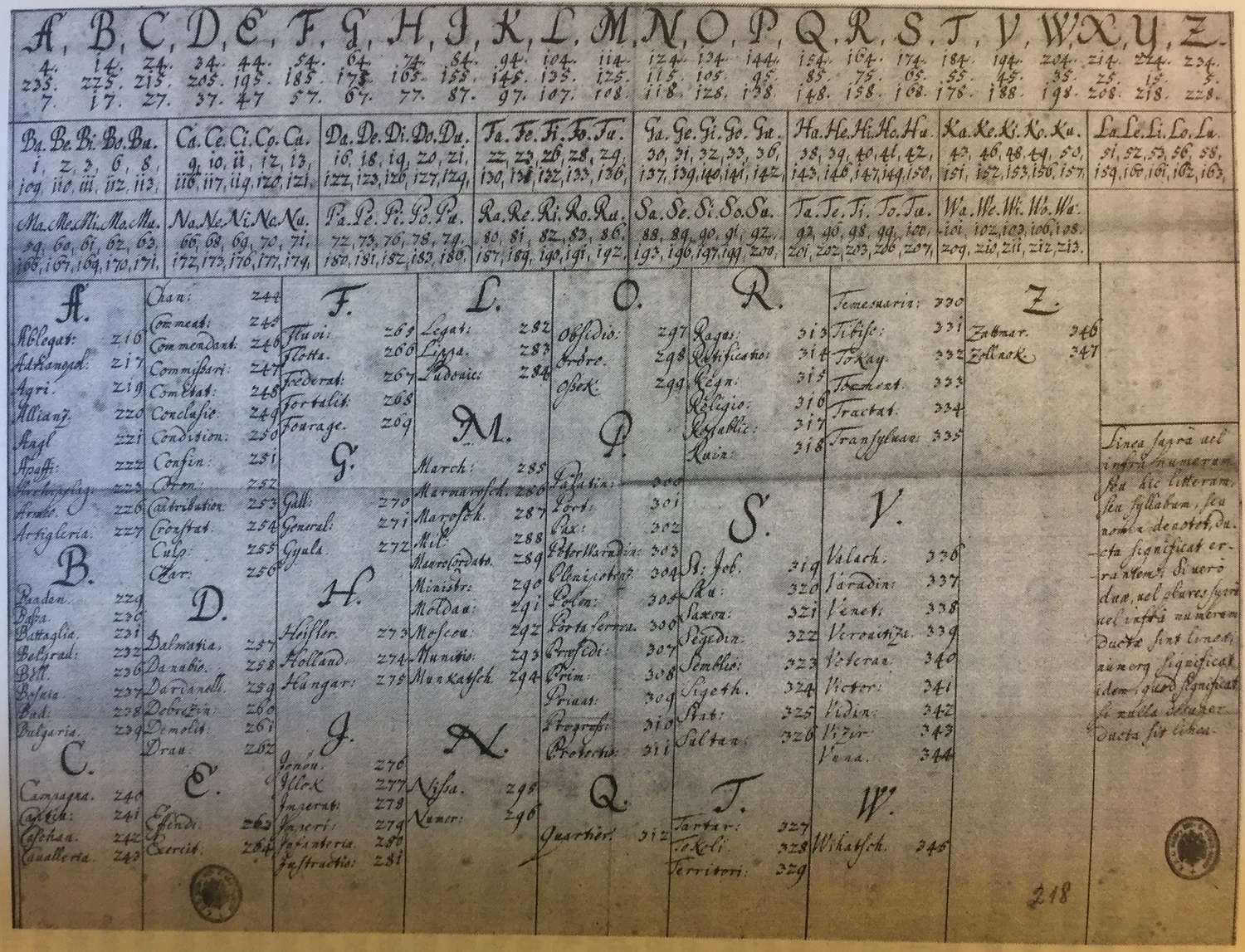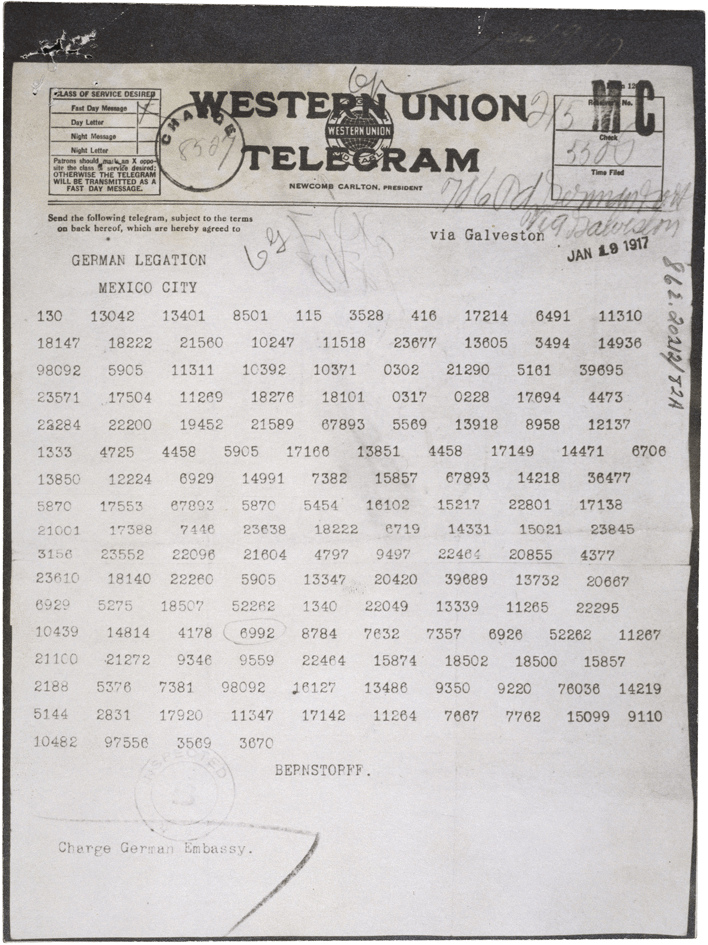|
Substitution Cipher
In cryptography, a substitution cipher is a method of encrypting in which units of plaintext are replaced with the ciphertext, in a defined manner, with the help of a key; the "units" may be single letters (the most common), pairs of letters, triplets of letters, mixtures of the above, and so forth. The receiver deciphers the text by performing the inverse substitution process to extract the original message. Substitution ciphers can be compared with transposition ciphers. In a transposition cipher, the units of the plaintext are rearranged in a different and usually quite complex order, but the units themselves are left unchanged. By contrast, in a substitution cipher, the units of the plaintext are retained in the same sequence in the ciphertext, but the units themselves are altered. There are a number of different types of substitution cipher. If the cipher operates on single letters, it is termed a simple substitution cipher; a cipher that operates on larger groups of lett ... [...More Info...] [...Related Items...] OR: [Wikipedia] [Google] [Baidu] |
ROT13
ROT13 is a simple letter substitution cipher that replaces a letter with the 13th letter after it in the Latin alphabet. ROT13 is a special case of the Caesar cipher which was developed in ancient Rome, used by Julius Caesar in the 1st century BC. An early entry on the Timeline of cryptography. ROT13 can be referred by "Rotate13", "rotate by 13 places", hyphenated "ROT-13" or sometimes by its Autological word, autonym "EBG13". Description Applying ROT13 to a piece of text requires examining its alphabetic characters and replacing each one by the letter 13 places further along in the alphabet, wrapping back to the beginning as necessary. When encoding a message, A becomes N, B becomes O, and so on up to M, which becomes Z. Then the sequence continues at the beginning of the alphabet: N becomes A, O becomes B, and so on to Z, which becomes M. When decoding a message, the same substitution rules are applied, but this time on the ROT13 encrypted text. Other characters, such as ... [...More Info...] [...Related Items...] OR: [Wikipedia] [Google] [Baidu] |
Ciphertext
In cryptography, ciphertext or cyphertext is the result of encryption performed on plaintext using an algorithm, called a cipher. Ciphertext is also known as encrypted or encoded information because it contains a form of the original plaintext that is unreadable by a human or computer without the proper cipher to decrypt it. This process prevents the loss of sensitive information via hacking. Decryption, the inverse of encryption, is the process of turning ciphertext into readable plaintext. Ciphertext is not to be confused with codetext because the latter is a result of a code, not a cipher. Conceptual underpinnings Let m\! be the plaintext message that Alice wants to secretly transmit to Bob and let E_k\! be the encryption cipher, where _k\! is a secret key, cryptographic key. Alice must first transform the plaintext into ciphertext, c\!, in order to securely send the message to Bob, as follows: : c = E_k(m). \! In a symmetric-key system, Bob knows Alice's encryption key. ... [...More Info...] [...Related Items...] OR: [Wikipedia] [Google] [Baidu] |
Babington Postscript
Babington may refer to: *Babington family *Babington (surname) *Babington, Somerset, England, a small village between Radstock and Frome *Babington House, an example of Georgian architecture in Somerset, England *Babington Academy, a school in Leicester, England *Babington's tea room, a traditional English tearoom in Rome *Babingtonite, mineral named after William Babington *Babington Path, a road in Hong Kong See also *Babington Plot, a 16th-century conspiracy in England *Babbington {{disambiguation ... [...More Info...] [...Related Items...] OR: [Wikipedia] [Google] [Baidu] |
Unicity Distance
In cryptography, unicity distance is the length of an original ciphertext needed to break the cipher by reducing the number of possible spurious keys to zero in a brute force attack. That is, after trying every possible key, there should be just one decipherment that makes sense, i.e. expected amount of ciphertext needed to determine the key completely, assuming the underlying message has redundancy. Claude Shannon defined the unicity distance in his 1949 paper " Communication Theory of Secrecy Systems". Consider an attack on the ciphertext string "WNAIW" encrypted using a Vigenère cipher with a five letter key. Conceivably, this string could be deciphered into any other string—RIVER and WATER are both possibilities for certain keys. This is a general rule of cryptanalysis: with no additional information it is impossible to decode this message. Of course, even in this case, only a certain number of five letter keys will result in English words. Trying all possible keys w ... [...More Info...] [...Related Items...] OR: [Wikipedia] [Google] [Baidu] |
Cryptogram
A cryptogram is a type of puzzle that consists of a short piece of encrypted text. Generally the cipher used to encrypt the text is simple enough that the cryptogram can be solved by hand. Substitution ciphers where each letter is replaced by a different letter, number, or symbol are frequently used. To solve the puzzle, one must recover the original lettering. Though once used in more serious applications, they are now mainly printed for entertainment in newspapers and magazines. Other types of classical ciphers are sometimes used to create cryptograms. An example is the book cipher, where a book or article is used to encrypt a message. History The ciphers used in cryptograms were created not for entertainment purposes, but for real encryption of military or personal secrets. The first use of the cryptogram for entertainment purposes occurred during the Middle Ages by monks who had spare time for intellectual games. A manuscript found at Bamberg states that Irish visitor ... [...More Info...] [...Related Items...] OR: [Wikipedia] [Google] [Baidu] |
English Language
English is a West Germanic language that developed in early medieval England and has since become a English as a lingua franca, global lingua franca. The namesake of the language is the Angles (tribe), Angles, one of the Germanic peoples that Anglo-Saxon settlement of Britain, migrated to Britain after its End of Roman rule in Britain, Roman occupiers left. English is the list of languages by total number of speakers, most spoken language in the world, primarily due to the global influences of the former British Empire (succeeded by the Commonwealth of Nations) and the United States. English is the list of languages by number of native speakers, third-most spoken native language, after Mandarin Chinese and Spanish language, Spanish; it is also the most widely learned second language in the world, with more second-language speakers than native speakers. English is either the official language or one of the official languages in list of countries and territories where English ... [...More Info...] [...Related Items...] OR: [Wikipedia] [Google] [Baidu] |
Frequency Distribution
In statistics, the frequency or absolute frequency of an Event (probability theory), event i is the number n_i of times the observation has occurred/been recorded in an experiment or study. These frequencies are often depicted graphically or tabular form. Types The cumulative frequency is the total of the absolute frequencies of all events at or below a certain point in an ordered list of events. The Empirical probability, relative frequency (or ''empirical probability'') of an event is the absolute frequency Normalizing constant, normalized by the total number of events: : f_i = \frac = \frac. The values of f_i for all events i can be plotted to produce a frequency distribution. In the case when n_i = 0 for certain i, pseudocounts can be added. Depicting frequency distributions A frequency distribution shows a summarized grouping of data divided into mutually exclusive classes and the number of occurrences in a class. It is a way of showing unorganized data notably to sh ... [...More Info...] [...Related Items...] OR: [Wikipedia] [Google] [Baidu] |
Cryptanalysis
Cryptanalysis (from the Greek ''kryptós'', "hidden", and ''analýein'', "to analyze") refers to the process of analyzing information systems in order to understand hidden aspects of the systems. Cryptanalysis is used to breach cryptographic security systems and gain access to the contents of encrypted messages, even if the cryptographic key is unknown. In addition to mathematical analysis of cryptographic algorithms, cryptanalysis includes the study of side-channel attacks that do not target weaknesses in the cryptographic algorithms themselves, but instead exploit weaknesses in their implementation. Even though the goal has been the same, the methods and techniques of cryptanalysis have changed drastically through the history of cryptography, adapting to increasing cryptographic complexity, ranging from the pen-and-paper methods of the past, through machines like the British Bombes and Colossus computers at Bletchley Park in World War II, to the mathematically advanced ... [...More Info...] [...Related Items...] OR: [Wikipedia] [Google] [Baidu] |
Key Size
In cryptography, key size or key length refers to the number of bits in a key used by a cryptographic algorithm (such as a cipher). Key length defines the upper-bound on an algorithm's security (i.e. a logarithmic measure of the fastest known attack against an algorithm), because the security of all algorithms can be violated by brute-force attacks. Ideally, the lower-bound on an algorithm's security is by design equal to the key length (that is, the algorithm's design does not detract from the degree of security inherent in the key length). Most symmetric-key algorithms are designed to have security equal to their key length. However, after design, a new attack might be discovered. For instance, Triple DES was designed to have a 168-bit key, but an attack of complexity 2112 is now known (i.e. Triple DES now only has 112 bits of security, and of the 168 bits in the key the attack has rendered 56 'ineffective' towards security). Nevertheless, as long as the security (understood ... [...More Info...] [...Related Items...] OR: [Wikipedia] [Google] [Baidu] |
The Wall Street Journal
''The Wall Street Journal'' (''WSJ''), also referred to simply as the ''Journal,'' is an American newspaper based in New York City. The newspaper provides extensive coverage of news, especially business and finance. It operates on a subscription model, requiring readers to pay for access to most of its articles and content. The ''Journal'' is published six days a week by Dow Jones & Company, a division of News Corp. As of 2023, ''The'' ''Wall Street Journal'' is the List of newspapers in the United States, largest newspaper in the United States by print circulation, with 609,650 print subscribers. It has 3.17 million digital subscribers, the second-most in the nation after ''The New York Times''. The newspaper is one of the United States' Newspaper of record, newspapers of record. The first issue of the newspaper was published on July 8, 1889. The Editorial board at The Wall Street Journal, editorial page of the ''Journal'' is typically center-right in its positio ... [...More Info...] [...Related Items...] OR: [Wikipedia] [Google] [Baidu] |



